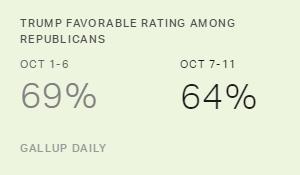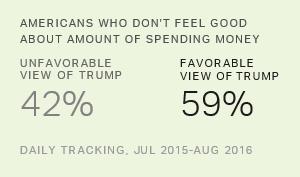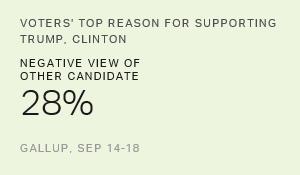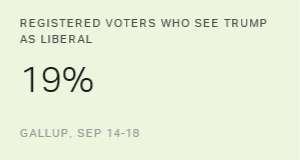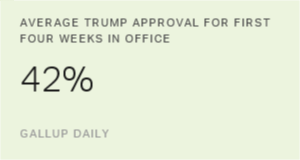Story Highlights
- Trump's unfavorables rose from 30% to 33% among Republicans
- Both candidates receive high unfavorables from the opposite party
- Independents are slightly more positive about Clinton
PRINCETON, N.J. -- Donald Trump's favorable rating among Republicans dropped from 69% to 64% in the fallout after The Washington Post released a 2005 video in which he made lewd comments about women, and after the second presidential debate on Sunday night. Trump's unfavorable rating ticked up slightly from 30% to 33%. There was virtually no change in Trump's already poor image among independents or Democrats.
| Favorable | Unfavorable | |||||||||||||||||||||||||||||||||||||||||||||||||||||||||||||||||||||||||||||||||||||||||||||||||||
|---|---|---|---|---|---|---|---|---|---|---|---|---|---|---|---|---|---|---|---|---|---|---|---|---|---|---|---|---|---|---|---|---|---|---|---|---|---|---|---|---|---|---|---|---|---|---|---|---|---|---|---|---|---|---|---|---|---|---|---|---|---|---|---|---|---|---|---|---|---|---|---|---|---|---|---|---|---|---|---|---|---|---|---|---|---|---|---|---|---|---|---|---|---|---|---|---|---|---|---|---|
| % | % | |||||||||||||||||||||||||||||||||||||||||||||||||||||||||||||||||||||||||||||||||||||||||||||||||||
| Republicans | ||||||||||||||||||||||||||||||||||||||||||||||||||||||||||||||||||||||||||||||||||||||||||||||||||||
| Oct 1-6 | 69 | 30 | ||||||||||||||||||||||||||||||||||||||||||||||||||||||||||||||||||||||||||||||||||||||||||||||||||
| Oct 7-11 | 64 | 33 | ||||||||||||||||||||||||||||||||||||||||||||||||||||||||||||||||||||||||||||||||||||||||||||||||||
| Independents/Other/Don't know | ||||||||||||||||||||||||||||||||||||||||||||||||||||||||||||||||||||||||||||||||||||||||||||||||||||
| Oct 1-6 | 26 | 67 | ||||||||||||||||||||||||||||||||||||||||||||||||||||||||||||||||||||||||||||||||||||||||||||||||||
| Oct 7-11 | 26 | 68 | ||||||||||||||||||||||||||||||||||||||||||||||||||||||||||||||||||||||||||||||||||||||||||||||||||
| Democrats | ||||||||||||||||||||||||||||||||||||||||||||||||||||||||||||||||||||||||||||||||||||||||||||||||||||
| Oct 1-6 | 5 | 93 | ||||||||||||||||||||||||||||||||||||||||||||||||||||||||||||||||||||||||||||||||||||||||||||||||||
| Oct 7-11 | 5 | 92 | ||||||||||||||||||||||||||||||||||||||||||||||||||||||||||||||||||||||||||||||||||||||||||||||||||
| Gallup | ||||||||||||||||||||||||||||||||||||||||||||||||||||||||||||||||||||||||||||||||||||||||||||||||||||
Hillary Clinton over the past five days has seen her favorable rating rise from 81% to 84% among Democrats, but take a slightly negative turn among independents, from 35% to 32%. Clinton herself has been the focus of news events, including WikiLeaks-released transcripts of emails involving Clinton, her campaign strategy and Wall Street speeches. Gallup polling finds that debate watchers saw Clinton as the winner of Sunday night's debate.
| Favorable | Unfavorable | |||||||||||||||||||||||||||||||||||||||||||||||||||||||||||||||||||||||||||||||||||||||||||||||||||
|---|---|---|---|---|---|---|---|---|---|---|---|---|---|---|---|---|---|---|---|---|---|---|---|---|---|---|---|---|---|---|---|---|---|---|---|---|---|---|---|---|---|---|---|---|---|---|---|---|---|---|---|---|---|---|---|---|---|---|---|---|---|---|---|---|---|---|---|---|---|---|---|---|---|---|---|---|---|---|---|---|---|---|---|---|---|---|---|---|---|---|---|---|---|---|---|---|---|---|---|---|
| % | % | |||||||||||||||||||||||||||||||||||||||||||||||||||||||||||||||||||||||||||||||||||||||||||||||||||
| Republicans | ||||||||||||||||||||||||||||||||||||||||||||||||||||||||||||||||||||||||||||||||||||||||||||||||||||
| Oct 1-6 | 7 | 92 | ||||||||||||||||||||||||||||||||||||||||||||||||||||||||||||||||||||||||||||||||||||||||||||||||||
| Oct 7-11 | 7 | 92 | ||||||||||||||||||||||||||||||||||||||||||||||||||||||||||||||||||||||||||||||||||||||||||||||||||
| Independents/Other/Don't know | ||||||||||||||||||||||||||||||||||||||||||||||||||||||||||||||||||||||||||||||||||||||||||||||||||||
| Oct 1-6 | 35 | 58 | ||||||||||||||||||||||||||||||||||||||||||||||||||||||||||||||||||||||||||||||||||||||||||||||||||
| Oct 7-11 | 32 | 60 | ||||||||||||||||||||||||||||||||||||||||||||||||||||||||||||||||||||||||||||||||||||||||||||||||||
| Democrats | ||||||||||||||||||||||||||||||||||||||||||||||||||||||||||||||||||||||||||||||||||||||||||||||||||||
| Oct 1-6 | 81 | 16 | ||||||||||||||||||||||||||||||||||||||||||||||||||||||||||||||||||||||||||||||||||||||||||||||||||
| Oct 7-11 | 84 | 13 | ||||||||||||||||||||||||||||||||||||||||||||||||||||||||||||||||||||||||||||||||||||||||||||||||||
| Gallup | ||||||||||||||||||||||||||||||||||||||||||||||||||||||||||||||||||||||||||||||||||||||||||||||||||||
The gulf between the partisan ratings of the two candidates at this point is substantial. Trump now has a 64% favorable rating among Republicans (for Oct. 7-11), while Clinton enjoys an 84% favorable rating among Democrats. Both candidates have high unfavorables among those in the opposing party, while Clinton has a slight edge among independents.
Though the 2005 video of Trump came out before Gallup interviewing began on Friday, his image did not begin to deteriorate among Republicans until the weekend, perhaps reflecting a delayed reaction to Republican leaders' public drop in support. Across the four days, Oct. 8-11, Trump's favorable among Republicans is 61% with a 36% unfavorable rating.
Given the lack of change in ratings among independents and Democrats, the effect of these events on Trump's image among Americans as a whole is slight. For the six days through Oct. 6, Trump averaged a 32% favorable, 64% unfavorable rating. Over the past five days, Oct. 7-11, Trump's favorable rating was 31%, with a similar one-percentage-point rise in his unfavorables, to 65%. Clinton's favorable among all Americans also remained stable, with her favorable dropping by one point (to 41%) while her unfavorable went up by one point (to 55%).
Americans Continue to Report More Recall of News About Trump Than Clinton
By Monday night, 92% of Americans recalled having read, seen or heard something about Trump in the last day or two. That compares with 84% for Clinton -- even though the two presidential candidates had nearly equal speaking time on stage at Sunday's debate in St. Louis. The 92% recall figure for Trump is the highest for either candidate since Gallup tracking of this measure began in July. Recall of hearing about Trump dropped somewhat by Tuesday night, but remained higher than for Clinton. This pattern contrasts with the days after the first debate (Sept. 26), when Americans' recall of having heard about the two candidates was essentially equal.
The release of the video on Friday did not appear to increase Americans' recall of having heard about the candidates, perhaps because attention to news is lower over the weekend in general. It wasn't until the day after the debate that recall jumped for both candidates.
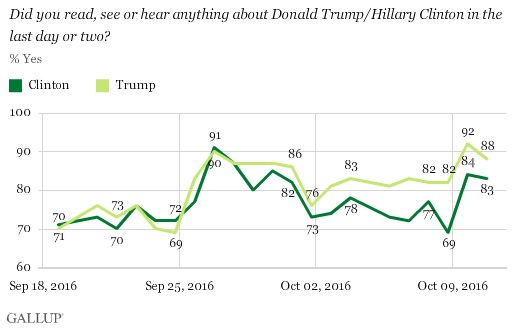
What Americans Are Reading, Hearing or Seeing About the Candidates
In conjunction with Georgetown University and the University of Michigan, Gallup is tracking exactly what Americans say they have read, seen or heard about the candidates on a daily basis. The following summarizes the findings for each of the past five days.
-
Oct. 7. The story of Trump's 2005 comments broke Friday afternoon, and by Friday evening, it was apparent that many U.S. adults had heard about it. The most common word Americans used in reporting what they had heard about Trump on Friday night was "woman," more frequently mentioned than words such as "debate" and "tax." The most common word Republicans used in their recall of Trump was "debate," while "woman" was the most common for Democrats and independents.
Meanwhile, Clinton was less prominent in Americans' minds, as noted previously. The most frequent words used to describe what people had heard about Clinton were "email," "debate" and "campaign." -
Oct. 8. References to the Trump video dominated Americans' descriptions of what they recently heard about Trump on Saturday. "Women" or "woman" was about three times more common in people's answers than the next-most-frequent word.
For Clinton, "email" was the most common word used in people's descriptions of what they heard, twice as likely as the next-most-common word, "speech." -
Oct. 9. Interviewing on Sunday was conducted before the beginning of the second presidential debate. For Trump, the most common word used in respondents' answers was "woman" or "women." The word "email" remained the most common one used in the description of what respondents recently heard about Clinton.
-
Oct. 10. In a rare convergence, the most common word Americans used when recalling what they had read, seen or heard about both candidates was the same: "debate." However, "woman" was the second-most-mentioned word for Trump and "email" was in second place for Clinton.
-
Oct. 11. "Debate" continued to be the most common word for both candidates Tuesday night, but the respective controversies surrounding each candidate did not fade from the public eye. After "debate," the next two most common substantive words for Trump were "woman"/"women" and "tape." Trump's claim, repeated several times in Sunday's debate, that the video represented "locker room talk" also percolated into the results. The words "locker" and "room" were among the 10 most common words Americans used to describe what they recently heard about Trump.
For Clinton, Americans frequently used the words "email," "leak," "lie" and "WikiLeak" in their responses. Still, "debate" was by far the most common word.
Bottom Line
Gallup typically reports Americans' attitudes about the candidates on the basis of seven-day rolling averages in order to provide reliably stable estimates. It will thus be this coming weekend before the effect of the recent events on the two candidates' images can be fully assessed. At this point, the data suggest that Americans are paying close attention to campaign events -- particularly the debate -- and that, at least in the short term, Trump's image among his own partisans has taken a hit, while Clinton has modestly shored up her image among Democrats.
Historical data are available in Gallup Analytics.
Survey Methods
Results for this Gallup poll are based on telephone interviews conducted Oct. 1-11, 2016, on the Gallup U.S. Daily survey, with random samples of approximately 500 adults per night, aged 18 and older, living in all 50 U.S. states and the District of Columbia. For results based on one night's sample of national adults, the margin of sampling error is ±5 percentage points at the 95% confidence level. For results based on the aggregated samples over Oct. 1-6, and 7-11, the margin of sampling error is ±3 percentage points at the 95% confidence level. All reported margins of sampling error include computed design effects for weighting.
Each sample of national adults includes a minimum quota of 60% cellphone respondents and 40% landline respondents, with additional minimum quotas by time zone within region. Landline and cellular telephone numbers are selected using random-digit-dial methods.
Learn more about how the Gallup U.S. Daily works.
